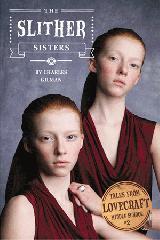
Professor Gargoyle
Published October 2012 and January 2013, Quirk Books. Hardback. List price, £10.99
Appropriate for ages 7-11.
From the cover of Professor Gargoyle:
‘Strange things are happening at Lovecraft Middle School. Rats are leaping frm lockers. Students are disappearing. The school library is a labryinth of secret coridors. and the science teacher is acting very, very, perculiar. Robert Arthur knew that seventh grade was going to be weird, but this is ridiculous!
With the help of some unlikely new friends, Robert discovers theres more to Lovecraft Middle Schol than meets the eye. Can he uncover the secrets of the school before it’s too late?’
It’s really difficult to stick to the old adage of never judging a book by its cover when you get a book with a cover like this.The lenticular covers of each book in the Tales from Lovecraft Middle School series morph as you move them: the dignified looking bearded man becomes a horned beast; the svelte, wan twin sisters become scaled hydras. It’s sure to pull in reluctant readers and it made me want to dive in immediately.
It is, perhaps, a little odd to describe a paranormal story with an antagonist who eats live hamsters as ‘comforting’ and ‘warm’, but that’s exactly what the first two books in Charles Gilman’s middle readers series are. Similar to RL Stein’s Goosebumps but far wittier, far creepier and far more intelligently written, " target="_blank">Professor Gargoyle and " target="_blank">Slither Sisters follow awkward pre-teen everykid Robert Arthur as he arrives at the newly built state-of-the-art Lovecraft Middle School, a place where the mysterious, gilt and dust world of the supernatural sits beside the digital chalkboard and brightly anonymous fittings of a super-modern school campus.

slither Sisters
The stories are engrossing. What child does not fantasize that their science teacher might secretly be a demon or the cool, popular girls running for class President Medusa- headed monsters? This is the force that drives the series, which, though inspired by HP Lovecraft, has none of his overwrought prose. It’s clear Gilman knows his characters inside out and cares deeply for his audience. Never condescending, always bright and often funny, its difficult to find a downside to Gilman’s storytelling.
Intertexual references to Lovecraft abound. Monsters are borrowed from the Cthulhu Mythos, philosophising that,
The Great Old Ones have the intelligence of ten thousand men combined. We should not question their actions.
Professor Gargoyle, p. 73
Though the books don’t explore too deeply Lovecraftian philosophy the groundwork is laid for future books in the series to delve further. In another nod to Lovecraft the books’ accompanying website plays Camille Saint-Saëns Dance Macabre.
I’m always keen on books that encourage free-thinking and Professor Gargoyle really hits the mark on that front. The book raises issues around trust and the blind acceptance of authority and subtly teaches the power of knowledge for both positive and negative purposes. When our protagonist is forced into an uneasy alliance with his former bully after an unfortunate saving-his-life incident, Robert is neither too quick to trust nor unwilling to move forward without assurances of a change in behavior. His development is a clear strand running through the book. By the end of Professor Gargoyle Robert has made learned the value of friendship,
In spite of everything that had happened, Robert was feeling good about himself. Sure, he’d never be like the characters in his favourite books, the kids with secret superpowers to help them escape any situation. But that wad okay. He had started the school year with zero friends, and now he had three. [...] Whatever weird things happened at Lovecraft Middle School, at least he wouldn’t have to face them alone.
p.165
Robert may not feel likely superhero, but he’s capable of amazing feats. Especially when he has friends at his side. He is socially aware, commenting more than once on the arbitrary nature of gender roles (though, as eleven year olds are wont to so, generally conforming to them) and wise to the social hierarchies of middle school without being in thrall to them.
By the beginning of Slither Sisters Robert’s own development and personal narrative become a bigger part of the story, a trend which I would love to see continue as the series progresses.
It is a necessary trope of adventure stories starring young people that parents are largely absent. Our protagonists need room to grow and to act and it’s difficult to do that with Mum looking over your shoulder. As such Robert’s mother is a mainly absent character, but her appearances are sweetly rendered, and occasionally cringingly hilarious (her gift of a ‘Puberty Kit’ at the beginning of Slither Sisters made me blush with pure glee).
Slither Sisters picks up exactly where Professor Gargoyle leaves off. The second novel is a little slower in the opening chapters, by virtue of the necessary recap of Professor Gargoyle‘s major plot points, but it too delivers in the end and deepens our understanding of the parallel universe existing beside Lovecraft Middle School. As such, both books deserve a mark of 8.5 out of 10.
Book three in the series, Teacher’s Pest, and book four, Substitute Creature, are due to be released later this year. I look forward to checking them both out.
